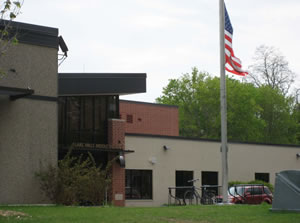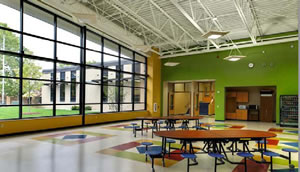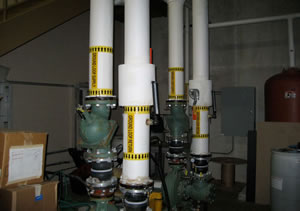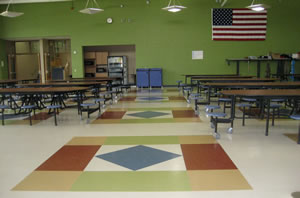Building Sustainable Schools

PHOTO BY SCOTT BERMAN
It wasn't exactly a walk in the park in Lake Mills, Wisc. Although the Lake Mills Middle School building needed a major upgrade, district voters had rejected referendums to do so several times over the years.
But administrators kept at it, eventually bringing in consultants to, among other things, survey the community to find key drivers. Among those found: enhancing education, and a desire to minimize waste, reports Theresa Lehman, LEED Fellow and director of Sustainable Services for Miron Construction Co.
Lehman explains that since minimizing waste is essentially the definition of sustainability, it naturally followed to set the bar high not only in terms of a renovated school’s educational value, but also its sustainability.
Getting there required communication that focused on the facts and figures, and on what a heightened level of sustainability could mean for students, staff, as well as district taxpayers.

PHOTO BY PHIL WESTON@WESTON IMAGERY
One key example illustrates. Lehman puts it this way: During the life cycle of an American school building, defined as 40 years, only about 11 percent of the costs go toward construction, another 25 percent toward renovating; 50 percent to operational costs; and 14 percent toward financing. Accordingly, what’s the best formula to bring what level of sustainability to bear on such expenses? Further, Lehman and her team worked with the district to develop a referendum financing plan that looked at many borrowing, debt and financing options and shared what they found in the district.
Fair enough. But the community had voted no before. So armed with the specifics, the district and consultant engaged the community in public forums, events, printed materials and mailers, and telephone and social media outreach and information about voting. It worked.
In November 2008, district voters approved the referendum. Construction got underway in 2009 and was completed in 2010. Lehman explains that LEED (Leadership in Energy & Environmental Design) was not originally intended, yet as renovation and expansion project unfolded, ever-loftier goals, including not just LEED but a high certification of the standard, came into view. More possibilities emerged when a slow economy resulted in very competitive bids, generating savings to cover additional sustainable features.
An upbeat attitude was evident. There was a feeling that “if we’re going to do this, let’s do it right,” as District Superintendent Dean Sanders said in a public meeting. The middle school’s principal, Jennifer Nicholson, says, “the goals got higher and higher” and stakeholders “fought for every single point,” eventually earning 58 out of a possible 80 LEED points. The school was certified LEED Platinum in 2011.

PHOTO BY SCOTT BERMAN
Pretty Cool. Lake Mills Middle School, in Lake Mills, Wis., features geothermal heating and cooling, energy-efficient lighting and other smart green features, and recently earned LEED Platinum. Pictured above is a section of the extensive geothermal heating and cooling system that uses 84 5-inch-diameter, 300-feet-deep wells that are buried under the baseball field and produce water that is around 50 degrees for the system.
There’s more to it: this $15-million project by Miron, architect Bray Associates and Sustainable Engineering Group, renovated the old 36,632-square-foot building, and added 57,231 square feet to create a green school that Lehman says was not only the first public elementary, middle or high school in the world to achieve LEED Platinum certification, but also came in $1.7-million under budget.
Two years out, the district is pleased. So much so that last November, Lake Mills voters approved, albeit narrowly in a tough economy, a referendum to borrow $8.7-million for a highly sustainable elementary school project, and Miron Construction is at work on it now.
Lehman points out that this latest project is to be part of the LEED v4 pilot program, which the administering U.S. Green Building Council describes in part as “having the potential to reduce CO2 emissions more than any other versions” of LEED.
So the district is forging ahead, and the experience back at the middle school is telling. According to officials, the middle school has cut energy consumption by 45 percent, saving $85,000 in energy costs over code annually. These and other facts and figures are part of an impressive presentation given by students when they conduct tours for visitors to their sustainable school — it’s part of how the district is using the building as a teaching and learning opportunity.
The presentation, along with Miron, details, among many other things, how the project:
- sourced roughly 60 percent of the school’s construction materials from the surrounding region, defined by the district as being within a 500-mile radius of Lake Mills;
- diverted almost 600 tons of construction waste from landfill disposal (77 percent of the waste generated);
- installed low-flow fixtures that consume 42-percent less water than code allows; and
- deploys other features such as daylighting, efficient interior and exterior lighting, and stormwater retention systems that ease the burden on the local municipality’s stormwater system.
SP&M recently toured the building with Principal Nicholson, who showed a number of sustainability features including components of the geothermal HVAC system. That system, the district points out, “brings in 30 percent more fresh air than what is required by Wisconsin’s code.” It was a notably cool and comfortable environment at the school on a hot afternoon.
The middle school’s indoor-air quality is another key feature. According to the district, the school’s air filtration system has filters with a Minimum Efficiency Reporting Value (MERV) 13 rating — MERV rating 16 is the highest possible. Low-emitting flooring, new furniture, tiles and adhesives at the school further enhance air quality, and are Greenguard Certified for Children and Schools, reports Miron.

PHOTO BY SCOTT BERMAN
Sanders and Nicholson note anecdotally how building users with allergies have noted significant improvement in their conditions, and that absenteeism seems to be dropping. That apparent outcome is among the “benefits to this that I never would have anticipated,” says Nicholson. Among the others: a tangible “sense of pride in the building,” she adds.
Sanders is looking forward to the completion of the elementary school project, and at this writing, was awaiting the final bid package for HVAC and interior work at the school, which is slated to open on Sept. 1, 2014. Bad weather in recent weeks has slowed progress somewhat. “I don’t mind waiting,” Sanders said, noting the benefits that the district is anticipating.
So although it wasn’t a walk in the park in Lake Mills, officials and builders are clearly pleased and are looking to set the bar even higher. Sanders offered some advice for other districts contemplating sustainable renovations or new construction. “Don’t short yourself or the community in terms of sustainability and LEED. Go for it.”
Some tips from the Lake Mills experience:
“Make sure you get the community to understand what a sustainable building is all about,” says Sanders.
Work with experts to explore all the funding and grant possibilities, both in terms of work on a building, and in terms of training in how to use building systems.
Think about your overall district master plan and how future projects could be highly sustainable, in the future, says Lehman.
Think holistically about how each building system will work in concert with each other; likewise how the contractor, engineer and architect will work together.
“Patience.” It’s how Nicholson describes the process of learning how to use a building and its leading edge systems, such as Lake Mills’ heating and cooling, to optimal effect.
“Involve everybody,” says Nicholson, including the community, faculty, and students, too. As for the last group, “make the kids feel that this is their building.”
Gather people with a commitment not only to envision, but also to create the most highly sustainable school possible.
This article originally appeared in the School Planning & Management August 2013 issue of Spaces4Learning.